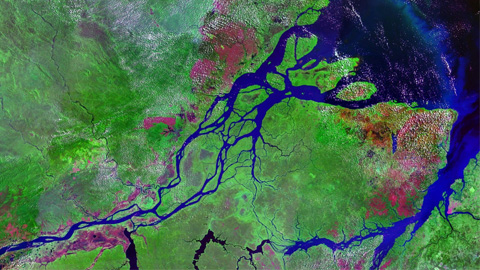An international research team with participation of the UAB team has succeeded in quantifying the volume of continental organic carbon stored in delta sediments from 75 million years ago. The research, published in Nature Geoscience, demonstrates that deltas are large stores of the planet's carbon and, therefore, important climate regulators over geological time periods.

A research team with participation of the Universitat Autònoma de Barcelona (UAB) has for the first time determined the efficiency of deltaic sediments to store continental organic carbon for hundreds of thousands of years. The study, published in Nature Geoscience, was led by researchers from the University of Calgary (Canada) and the Institut Français de Recherche pour l'Exploitation de la Mer (France), with the participation of Miquel Poyatos, lecturer in the Department of Geology at the UAB.
Terrestrial plants use atmospheric CO₂ and transform it into organic carbon for their growth. Once the plants and the living beings that consume them die, most of the organic carbon is returned to the atmosphere, but a small part is transported by rivers to the ocean, where it is accumulates in marine sediments. The burial and storage of this organic carbon of continental origin in marine sediments can reduce the Earth's atmospheric CO₂ levels, and thus regulate its climate cycle over geological timescales, which are intervals generally longer than one hundred thousand years.
The largest accumulation site of organic carbon in today's oceans is in deltaic areas, some of which are composed of large accumulations of sediment. Analysis of modern deltaic sediments, however, only provides information on the temporal and spatial characteristics of these complex sedimentary environments for a short period of time in geological terms. This complicates the calculation of their long-term organic carbon burial efficiency.
In the now-published study, researchers have determined the volume of organic carbon stored in a deltaic sedimentary succession accumulated during the Upper Cretaceous, 75 million years ago, in the Magallanes Basin of southern Chile. To calculate carbon burial rates on a geological scale, the researchers reconstructed the dimensions of the delta and quantified the organic content of the rock samples, combining this information with their own dating of the rocks from previous work.
The study has been done during a five-week field campaign analysing Upper Cretaceous rocks in the Magallanes Basin in southern Chile. Source: Chile Slope Systems.
The results show that up to almost 100 megatonnes of organic carbon of continental origin were stored in these sediments over a time period of approximately 100,000 to 900,000 years, at an annual burial rate of 2-16 tonnes per km²/year. These values are of a similar order of magnitude to organic carbon burial rates in modern deltas, such as the Amazon River.
"In this study we demonstrate that deltaic areas have been, are and probably will be large natural stores of continental organic carbon on our planet and, therefore, important climate regulators over geological time periods", says Miquel Poyatos. "Governments and institutions of countries with deltas in their territory have the need to protect, maintain and restore them, especially in the current context of climate change, sea level rise and sediment loss due to reservoirs", concludes the UAB researcher.
Article: Hage, S., Romans, B.W., Peploe, T.G.E., Poyatos-Moré, M., Ardakani, O.H., Bell, D., Englert R.G., Kaempfe-Droguett, S.A., Nesbit, P.R., Sherstan, G., Synnott, D.P. and Hubbard, S.M. (2022). High rates of organic carbon burial in submarine deltas maintained on geological timescales. Nature Geoscience. https://doi.org/10.1038/s41561-022-01048-4






